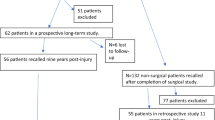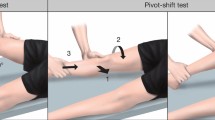Abstract
The planar topography of the anterior cruciate ligament (ACL) insertion was investigated and correlated to the use of the double-bundle/double tibial tunnel ACL reconstruction technique within the ACL tibial insertion area. The anteroposterior and mediolateral length of the tibial ACL attachment and the distances of the tibial insertion area from the anterior and posterior tibial borders were measured and the stability of the joint was tested using the double-bundle/double tibial tunnel ACL reconstruction technique. The anteroposterior length, 19.54 mm in men and 17.36 mm in women, of the ACL insertion, averaged approximately 40% of the total intercondylar anteroposterior dimension of the plateau. This broad distribution of insertion fibres ensures ligament tension and hence joint stability. The reported anteroposterior broad insertion of ACL fibres to the tibia is not sufficiently reproduced by the use of one or more bundles having a common tibial tunnel for the ACL reconstruction. In our view, this might be better achieved with two different bundles, with separate tunnels, and independent tensioning in different knee angles. This technique might achieve better results in human knee stability as opposed to other reported techniques.
Résumé
Une étude topographique de l’insertion du ligament croisé antérieur a recherchée une corrélation avec la technique du double tunnel/ double brin au niveau de la zone d’insertion tibiale. Les dimensions antéro-postérieure et médio-latérale de l’insertion tibiale ainsi que les distances entre les bords antérieur et postérieur du tibia et cette zone d’insertion étaient étudiées. La stabilité articulaire était testée après reconstruction par la technique du double brin avec double tunnel. La longueur antéro-postérieure de l’insertion - 19,54 mm chez l’homme et 17,36 chez la femme - représente approximativement 40% de la dimension antéro-postérieure du plateau tibial dans la région inter-condylienne. Cette distribution étendue de l’insertion des fibres assure la tension ligamentaire et en conséquence la stabilité articulaire. Cette insertion étendue n’est pas reproduite par l’utilisation d’un ou plusieurs brins passés dans un seul tunnel tibial. Nous pensons que cela peut être atteint en utilisant 2 brins et 2 tunnels avec une mise en tension indépendante dans les différentes positions du genou. Cette technique devrait donner de meilleurs résultats que les techniques habituellement proposées.



Similar content being viewed by others
References
Amis AA, Dawkins GPC (1991) Functional anatomy of the anterior cruciate ligament. Fibre bundle actions related to ligament replacements and injuries. ACL replacement with polyester fibre. J Bone Joint Surg Br 73(2):260–267
Arnoczky SP (1983) Anatomy of the anterior cruciate ligament. Clin Orthop 172:19–25
Buelow J-U, Siebold R, Ellermann A (2000) A new bicortical tibial fixation technique in ACL reconstruction with quadruple hamstring graft. Knee Surg Sports Traumatol Arthrosc 8:218–225
Cho KO (1975) Reconstruction of the anterior cruciate ligament by semitendinosus tenodesis. J Bone Joint Surg Am 57(5):608–612
Frank CB, Jackson DW (1997) The science of reconstruction of the anterior cruciate ligament. J Bone Joint Surg Am 79:1556–1576
Fetto JF, Marshall JL (1980) The natural history and diagnosis of anterior cruciate ligament insufficiency. Clin Orthop 147:29–38
Girgis FG, Marshall JL, Al Monajem ARS (1975) The cruciate ligaments of the knee joint: anatomical, functional and experimental analysis. Clin Orthop 106:216–321
Hara K, Kubo T, Suginoshita T, Shimizu C, Hirasawa Y (2000) Reconstruction of the anterior cruciate ligament using a double bundle. Arthroscopy 16:860–864
Johnson RJ (1983) The anterior cruciate ligament problem. Clin Orthop 172:14–18
Kennedy JC (1983) Application of prosthetics to anterior cruciate ligament reconstruction and repair. Clin Orthop 172:125–128
Muneta T, Sekiya I, Yagishita K, Ogiuchi T, Yamamoto H, Shinomiya K (1999) Two-bundle reconstruction of the anterior cruciate ligament using semitendinosus tendon with endo-buttons: operative technique and preliminary results. Arthroscopy 15:618–624
Norwood LA, Cross MJ (1979) Anterior cruciate ligament: functional anatomy of its bundles in rotatory instabilities. Am J Sports Med 7(1):23–26
Noyes FR, Barber SD (1992) The effect of a ligament-augmentation device on allograft reconstructions for chronic ruptures of the anterior cruciate ligament. J Bone Joint Surg Am 74(7):960–973
Noyes FR, Mooar PA, Mathews DS, Butler DL (1983) The symptomatic anterior cruciate-deficient knee. J Bone Joint Surg Am 65:154–162
O’Brien SJ, Warren RF, Pavlof H, Panariello R, Wickiewikz TL (1991) Reconstruction of the chronically insufficient anterior cruciate ligament with the central third of the patellar ligament. J Bone Joint Surg Am 73:278–286
O’Donoghue DH (1963) A method for replacement of the anterior cruciate ligament of the knee. J Bone Joint Surg Am 45:905–924
Odensten M, Gillquist J (1985) Functional anatomy of the anterior cruciate ligament and a rationale for reconstruction. J Bone Joint Surg Am 67(2):257–262
Papachristou G, Priftis G, Efstathopoulos N, Levidiotis C (1993) Acute rupture and chronic insufficiency of anterior cruciate ligament. Acta Orthop Hell 44:49–52
Papachristou G, Tilentzoglou A, Efstathopoulos N, Khaldi L (1998) Reconstruction of anterior cruciate ligament using the doubled tendon technique: an experimental study in rabbits. Knee Surg Sports Traumatol Arthrosc 6:246–252
Papachristou G, Sourlas J, Magnissalis EA (2003) Biomechanical evaluation of a double-bundle technique for the reconstruction of ACL. Biomechanics, Proceedings of the International Association of Science and Technology for Development (IASTED). ACTA Press, Calgary, pp 12–17
Paulos LE, Butler DL, Noyes FR, Grood ES (1983) Intra-articular cruciate reconstruction. Clin Orthop 172:78–84
Pederzini L, Adriani E, Botticella C, Tosi M (2000) Double tibial tunnel using quadriceps tendon in anterior cruciate ligament reconstruction. Arthroscopy 16(5):E9
Puddu G (1980) Method for reconstruction of the anterior cruciate ligament using the semitendinosus tendon. Am J Sports Med 8:402–404
Radford JPW, Amis AA (1990) Biomechanics of a double prosthetic ligament in the anterior cruciate ligament deficient knee. J Bone Joint Surg Br 72(6):1038–1043
Takeuchi R, Saito T, Mituhashi S, Suzuki E, Yamada I, Koshino T (2002) Double-bundle anatomic anterior cruciate ligament reconstruction using bone-hamstring-bone composite graft. Arthroscopy 18:550–555
Zarins B, Rowe CR (1986) Combined anterior cruciate-ligament reconstruction using semitendinosus tendon and iliotibial tract. J Bone Joint Surg Am 68(2):160–177
Author information
Authors and Affiliations
Corresponding author
Rights and permissions
About this article
Cite this article
Papachristou, G., Sourlas, J., Magnissalis, E. et al. ACL reconstruction and the implication of its tibial attachment for stability of the joint: anthropometric and biomechanical study. International Orthopaedics (SICO 31, 465–470 (2007). https://doi.org/10.1007/s00264-006-0213-9
Received:
Revised:
Accepted:
Published:
Issue Date:
DOI: https://doi.org/10.1007/s00264-006-0213-9




